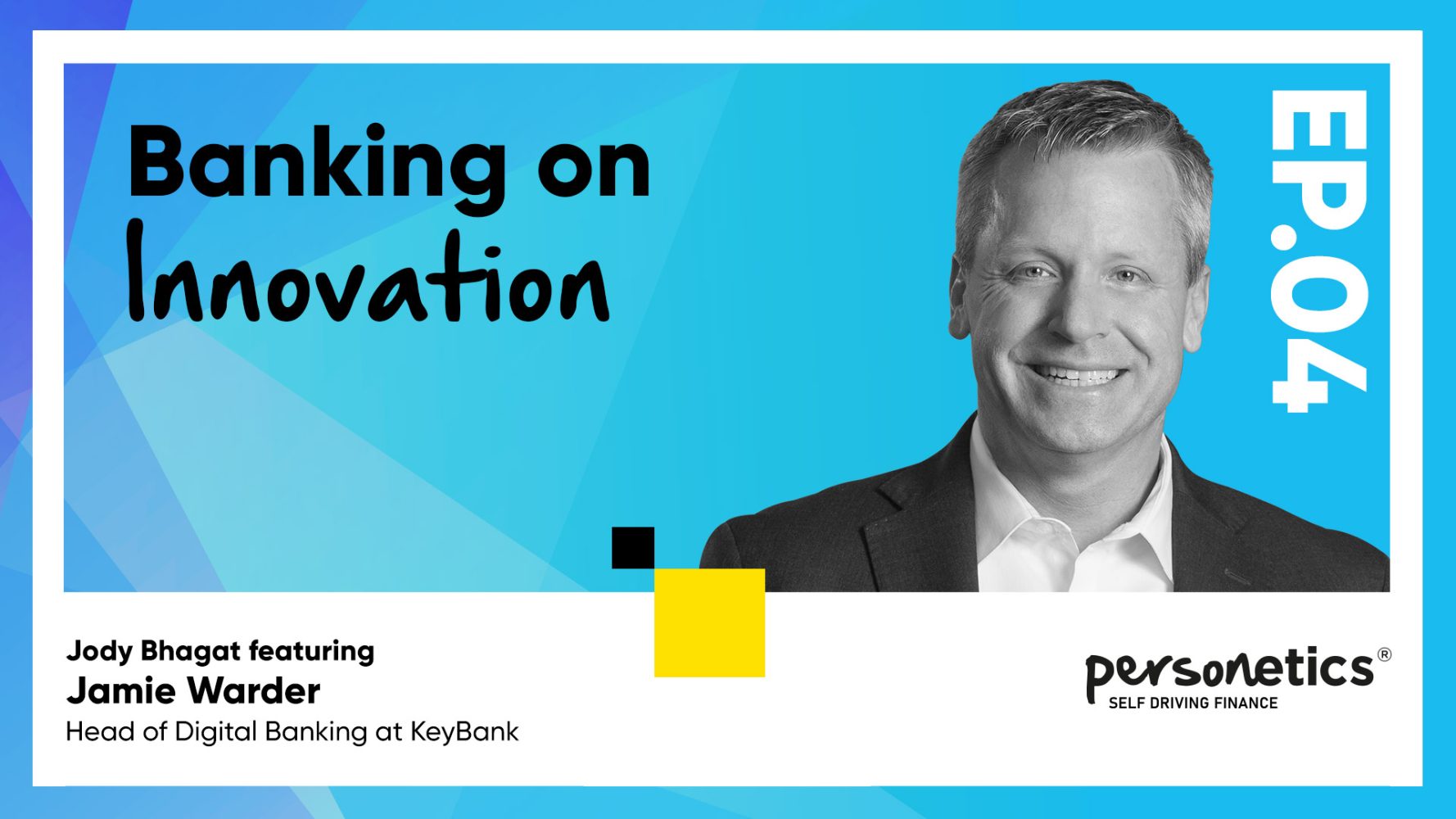November 10, 2022
Jamie Warder, Head of Digital for KeyBank: Three Rules for Successful Innovation

This week’s guest on Banking on Innovation is Jamie Warder, Head of Digital Banking for KeyBank, which has around 1,000 branches in 15 states. Jamie is a savvy industry veteran who is skilfully navigating the complex terrain of how regional banks can capitalize on both opportunities and threats from the burgeoning fintech ecosystem. KeyBank is taking bold and non-traditional steps to deliver on their digital ambitions – acquiring AQN, an analytics company, and Laurel Road, a student loan refinance operation which they are refashioning into a digital-led, full-service bank for the healthcare market.
Jamie brings a real appreciation for the financial services ecosystem and complex, competitive landscape. He combined new ideas about the capabilities necessary to serve customers with pragmatism about the speed and types of innovation possible.
“As much as we talk about the digital revolution, I think in many cases it’s a digital evolution,” he says. “We’ll be measuring the change over the course of many years or decades.”
Different parts of the market are also maturing at different paces. Therefore, how and where you innovate must be considered carefully.
“We’ve coined a term – ‘Targeted scale’ – which means we’re not going to out-scale the trillionaire banks at KeyBank. But what we can do is pick our spots, like renewable energy, low-income housing and healthcare, where we can really focus our time, effort and resources and create targeted scale… If you’re trying to be strong everywhere you’re probably strong nowhere.”

The 3 Rules for Successful Innovation
Drawing on his experience in different organizations – including the United States military, where he was a captain – Jamie observes three key rules for successful innovation.
- First, “you have to think about innovation in horizons. Thinking about what you can innovate this year might be different than innovation you’re thinking about five years from now.” The former may be “slight tweaks… relentless incrementalism” rather than true original thinking, while the latter may require thinking and design that never gets implemented.
- Second, organizations must avoid “innovating for the sake of innovating.” Instead, start with a clearly articulated strategy outlining your target market and how you are trying to serve it, then use that as a frame for innovation.
- Third, do not confine your innovation to technology, but consider processes and people too.
For example, says Jamie, he’s particularly proud that at KeyBank “We’ve been doing a lot of innovation on how to allow small start-up, nimble companies, typically that we’ve acquired, to keep their culture, spirit and speed, but within a larger regulated organization.”
The implication is that organizations cannot wait until they have achieved parity to start considering where they can innovate. It must be part of your agenda from the start. But equally, organizations must be intentional about their focus and accept that they cannot be innovative in every part of their business.
Why the competitive environment is like Lord of the Rings
The pressure to innovate is intense. Quoting a KeyBank board member, Jamie compared the competitive environment to Lord of the Rings: “You’re dealing with giants, you’re dealing with things nipping at your feet, you’re dealing with things at you in the air and on the ground…”
I asked Jamie to weigh in on the challenges faced by each player in this expansive ecosystem.
Challenger digital banks have “figured out how to do day-to-day checking and debit. It’s created growth. Their challenge is, how do we move beyond a single product? How do we look for other ways to take care of [our] customers while still figuring out monetization?”
Regional banks like KeyBank should not feel pressured to compete with the larger banks. The key to taking share is the principle of “Targeted scale” – picking your areas of innovation and competition narrowly and carefully.

How can you serve clients where they want to be served?
There is still plenty of opportunity for innovation, because banks’ digital capabilities are maturing at difference paces – as is digital adoption by customers.
While the service side of banking has been digitalized almost completely, sales fulfilment is further behind the curve, typically still involving people in-branch or over the phone. Meanwhile, advisory is “the next horizon… more nascent but growing over time.”
“In every category of financial services you’re going to find your digital-only crowd, your in-person-only crowd and the largest crowd is going to be those who do some of both, depending on the situation, the day or what they need. It’s going to be that way for a long time… So the right question becomes, how do you create the ability to serve clients where they want to be served?”
Most institutions still need to find a balance between their digital and physical services. This is a challenge “where Personetics can help,” noted Jamie, by offering banks the capability to capture customers’ financial and deliver personalized insights both digitally and in physical channels in a unified way.

3 macro-trends in banking that are set to grow
We ended with the same forward-looking question I ask every guest: What will customers demand from banks in the next three years that the industry may not be well prepared for?
Jamie identified 3 emerging macro-trends:
1. First, whilst in the past customers typically chose their bank because of geographic convenience, now banking communities are starting to coalesce around people with similar banking needs.
“30 years ago there was the firefighters’ credit union, and firefighters would do their financial services together [there]. Then you started seeing some big players in the affinity space, around teachers, the military… creating a kind of affinity in banking.”
This is exactly what KeyBank is trying to do with Laurel Road, by focusing on the healthcare industry.
2. The second trend is for algorithms to make financial decisions for customers, instead of leaving it to them to manage their own funds, which they may find difficult without adequate financial knowledge or guidance.
“We might start to see more accounts that are tied together with intelligence that knows, ‘Hey, does it make sense to move some money for you? If you have too much in your checking account, let’s get that into a savings account so it can earn interest.”
At Personetics we call this “Self-Driving Finance”, and we expect to see continued customer interest and adoption, particularly in this era of rising rates.
3. Finally, Jamie foresees a move towards embedded banking, where non-financial companies have financial services built into their services. He gave the example of a cosmetic surgeon who can finance an optional procedure for his patients, instead of requiring them to obtain financing from a bank.

“We are just scratching the surface on banking showing up where it’s actually needed as opposed to a one-off, separate function.”
A rapidly evolving competitive landscape can sometimes leave banks indecisive on where to place their bets to drive impact. Based on its actions, KeyBank is doubling down on the potential of analytics and digital-enabled experiences, and architecting a business model to embrace fintech innovation. Bring on the next stage of digital evolution!
How can you listen to the podcast?
Please tune in and join me and my guests on this journey. Episodes of Banking on Innovation are released every 2 weeks.
You can access new podcast episodes here: Spotify, Apple, and Google.
Want To See How Cognitive Banking and AI Can Transform Customer Engagement?
Request a Demo Now
Latest Posts

Truist's Performance Marketing Journey: From Merger Challenges to Million-Dollar Results

How Asia Pacific Banks Are Redefining AI-Driven Engagement

How iBank and Personetics are Transforming Personal Finance in Japan

Beyond Transactions: How Synovus is Creating Deeper Digital Engagement at Scale

4.5 Stars and 20% CTR: How BGL BNP Paribas’s Genius is Reinventing Digital Banking

The AI Implementation Reality Check









